Porsche 911 (F-Series) – The Story
The Original. The Porsche 911.
Story / Timeline / Model Guides / Gallery / Videos / Details & Series / Misc Data / FAQs / News / Features
Generation: First Generation
Known As: F-Body or Classic 911
Manufacturer: Porsche AG
Production Years: 1964 - 1974
Model Years: 1964 - 1974
Designer: Ferdinand A Porsche, Erwin Komenda
Body Style: 2-door coupe, 2-door targa
Layout: Rear-engine, RWD
Engines: 1.6 L Flat 4 (912), 2.0 L Flat 6, 2.2 L Flat 6, 2.4 L Flat 6, 2.5L Flat 6, 2.7 L Flat 6, 2.8 L Flat 6
Trans: 4-spd manual, 5-spd manual, 4-spd auto
Premiere: September 12, 1973
Successor: Porsche 911 (G-Body)
Buyers Guide (Coming Soon)
The Porsche 911 was introduced to the world in the fall of 1963 at the Frankfurt Motor Show. It was developed as a replacement for the highly successful Porsche Model 356. It was larger, more powerful, more comfortable and more competitive on the track than any other comparable car on the market at the time. The original air-cooled, boxer-engined 911 was in production from 1964 through 1989, but on this page, we are focused on the original F-Body cars. Info on the G-Body cars is found here.
We all know the 901 story don't we? A prototype of the 901, as it was called for a brief period, was unveiled at the Frankfurt Motor Show. Production slowly started in September 1964 and the 901 was shown at the October 1964 Paris Motor Show, barely one month after the start of production. Peugeot objected to the model number, saying that it had the rights to three-digit model numbers with a zero as the middle digit. Although this would only apply to sales in France, Porsche decided to just add a “1,” creating the 911. There were about 80 cars built and labeled 901 before the change.
It was decided to use the lower-cost 356 engine in the new 911 body and call the resulting model the 912. This was successful to the point that the 912 outsold the 911 two to one for a couple years. The last year for the 912 in this form was 1969. The first edition of the 911 was built around a 130 hp, 2.0 liter, flat-six, air-cooled, rear-mounted engine. In 1966 the beefier 160hp 911S was introduced as the first variation of the 911. The "S" which stood for "Super" boasted performance upgrades and modifications that included larger valves, a higher compression ratio, better porting and larger carbuerator jets. Along with the mechanical tweaks, the 911S also received chassis upgrades in the form of a rear anti-roll bar, Koni shocks, distinctive 5-spoke Fuchs alloy wheels and ventilated disc brakes. This really marked the beginning of the 911 as a genuine performance car. This was also the first year for the Targa.
For 1969 Porsche made the single biggest change to the 911 thus far by lengthening the wheelbase 2.5 inches to reduce the oversteer characteristics inherent to rear-engined cars. Pre-1969 cars are often referred to as the short-wheel base cars (SWB) and 1969 onwards called the long-wheelbase cars (LWB). In LWB cars, two 12-volt batteries were installed in each front corner in a further attempt to improve the handling, instead of the earlier bumper-weight solution. They also expanded the model range to three versions, which now included T, E, and S. The E and S got a new induction system in the form of mechanical fuel injection (MFI) to meet emission standard. The next two years, 1970 and 1971, can almost be taken as one step, since there were almost no differences in that time frame. The three model variants, T, E, and S, remained, but the 912 was dropped. Engine displacement was increased to 2.2 liters, the E and S retained mechanical fuel injection, and the T still met emissions with carburetors.
1972 and 1973 can also be taken as one group because there were very few changes from year to year. 1973 marked the end of the longhood 911, when, in 1974, the design of the original body style was changed in order to meet new bumper crash standards. The 1972 and 1973 engine displacement was increased again to 2.4 liters to gain back some power lost from compression ratio reductions to meet the new lower-octane lead-free fuel.. The Type 915 transmission was a totally new design. It was stronger and had a more user friendly H pattern for the first four gears, instead of the old dog-leg first gear that was down and to the left. 1972 was also the first and only time to date where the oil tank was mounted ahead of the right-rear wheel (other than the few 911Rs in 1967 and 1968) for weight distribution reasons.
We can't talk about the classic 911 without mentioning the most famous 911 of all. The 1973 911 Carrera RS was built largely to homologate the faster 911 RSR race car for GT racing and it may be the purest 911 ever made. It is still the GOAT.
This graphic breaks out the first generation Porsche 911 in terms of timelines and how to tell all the models apart. Click on the image to see it in higher definition. We split the timeline into entry level, standard level and sports-focused cars.
The wonderful internet has given us much more access to videos of the original 911.

The original 911 had a steel bodyshell that was 111 mm longer than the outgoing 356, giving the 911 a roomier cockpit and better handling. The suspension layout was MacPherson struts at the front with a fully independent back end was much more advanced than the 356 set up. The 911’s air-cooled all-alloy Flat 6 engine was the Type 901/01 and had dry-sump lubrication, overhead camshafts, hemispherical cylinder heads and a forged seven main bearing crankshaft. The new engine had a displacement of 1991 cc, with a 9.1:1 compression ratio and two triple-choke 40PI Solex carburettors. Peak output was 130 bhp at 6100 rpm. The transmission was a new Type 901 five-speed gearbox.
The design was the work of Ferdinand ‘Butzi’ Porsche and it clearly evolved from the 356 and it was initially available as a Coupe. Porsche quoted a weight of 1030 kg, a top speed of 131 mph and 0-60 mph time of 8.3 seconds. Production began in August 1964. April 1965 saw production of the Porsche 912 begin. Powered by the four cylinder 356 engine, it was conceived as an entry-level 911 and initially outsold the considerably more expensive six cylinder variant. The Targa was introduced in late 1966 and a 1967 model year.
In July 1966, Porsche unveiled an uprated 911 S model. It had a Type 901/02 engine with upgrades including bigger intake and exhaust valves plus hardened connecting rods and forged pistons. Compression was increased from 9.1 to 9.8:1 and two Weber 40 IDS carburetors were installed along with a more efficient gas-flowed three-to-one exhaust system. Power was 160 bhp at 6600 rpm. The 911 S also got Koni shocks as standard and a bigger front anti-roll bar. Ventilated disc brakes were fitted for the first time.
The O-series 911s were produced between August 1964 and July 1967 and during this time, 8520 standard Coupes were built and 3422 911 S Coupes. 718 911 Targas were also built, a figure that included both S and non-S variants. In August 1967, the O-series 911 was replaced by the A-series derivative.
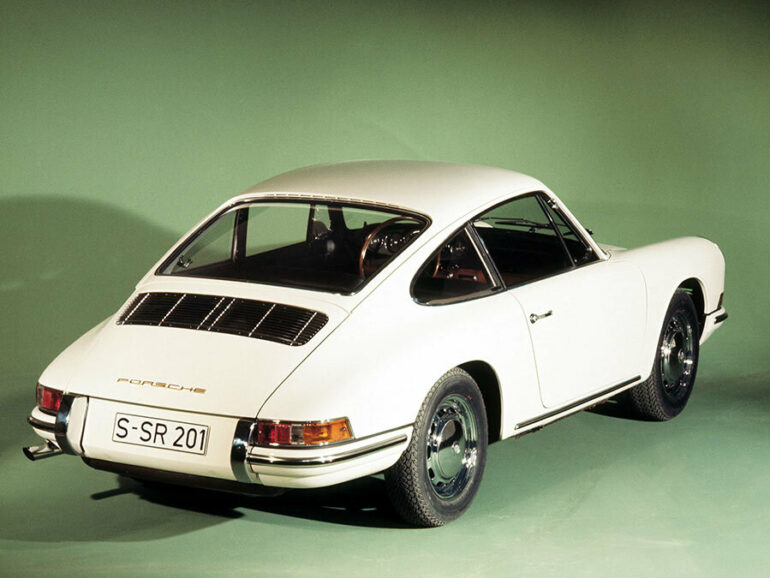
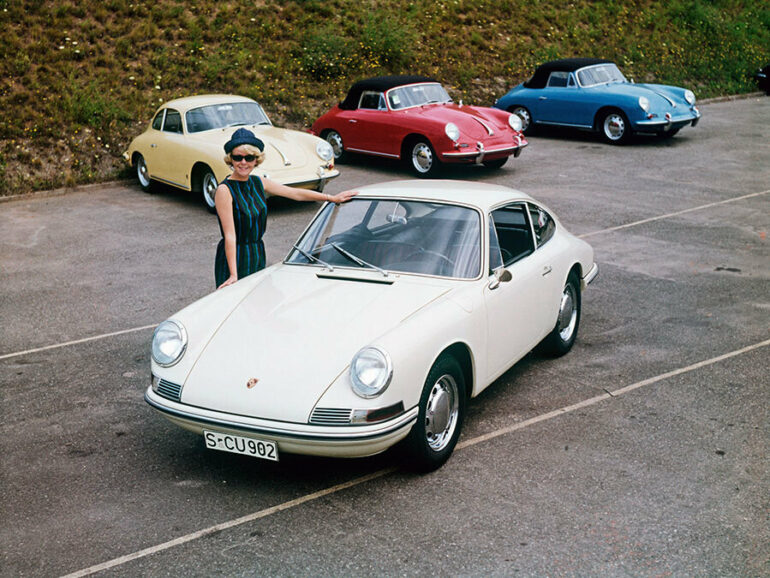
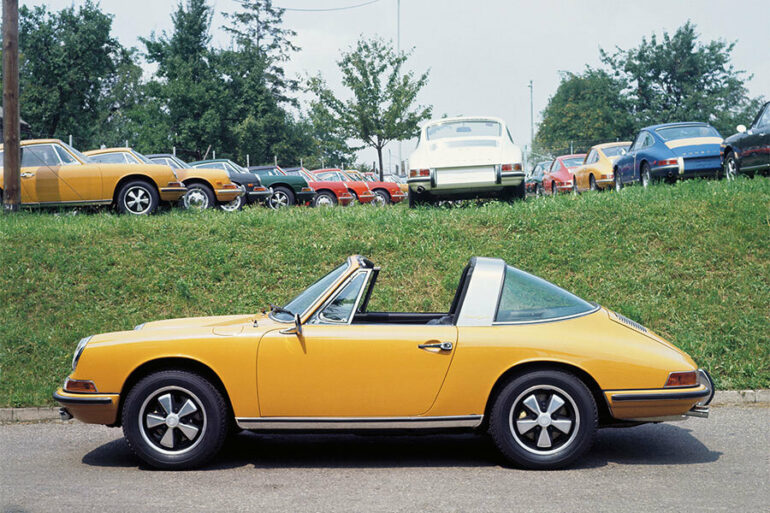

In 1967, the original 911 was replaced by the A-series. The 1968 model year A-series 911 was available in four basic varieties: the 911 T, the ‘normal’ 911, the 911 L and the 911 S. All four could be ordered with Coupe or Targa bodywork and with either a manual or semi-auto gearbox. The chassis and suspension was unchanged. The 911 did get a new brake system, dry-sumped engines with single overhead cams and a new Sportomatic transmission option.
Changes on the outside were subtle and came in the form of changed wipers, door handles changes to the cooling slats on the engine cover. US destined cars came with bumper overriders and thicker headlight shrouds.
The A-series 911 was discontinued in August 1968 to make way for the 1969 model year B-series change. B-series 911s got a 57mm longer wheelbase and larger rear brakes. Wheelarches got a subtle flare design and the indicators were a bit bigger too.
Porsche dropped the ‘normal’ 911 and 911 L in favor of a new mid-range model called the 911 E. The 911 E got Bosch mechanical fuel-injection and ignition, thus making them eligible to be sold in North America. The new Type 901/10 engine in the fuel-injected 911 S was further uprated with bigger intake and exhaust valves and a lightweight magnesium engine casing.
B-Series production stopped in July 1969 to make way for the C-series 1970 model year 911 which came with a bigger 2.2-litre engine.
The 2.2 liter 911s arrived for the 1970 and 1971 model years, available once again as either Coupe or Targa and with three engine tunes. The 125 bhp 911 T, the 155 bhp 911 E and the 180 bhp 911 S. The engines were bored out to 84mm and the engines got larger valves, new head gaskets and more cooling fins. The 911 E had softer cams to make it less spikey to drive on throttle, while the 911 S got a 10 bhp bump in power. The 911 E and 911 S got five-speed gearbox while the 911 T had only four-speeds.
The front suspension mounting points were moved 14 mm forward which increase wheelebase and made steering better at slow speeds. The E kept its hydro-pneumatic struts. Ventilated disc brakes were now fitted across the entire range, a big improvement. Also standard were 6 x 15-inch Fuchs forged alloy wheels. Cosmetically, no major changes were made.
C-series production started in August 1969 and continued until July 1970. The 1971 model year D-series 911 were next up, with several upgrades. The body was now galvanized and squirters were introduced to improve piston cooling. There was also a new type of sealed chain tensioner while minor detail alterations were made to the fuel-injection system. D-series production ended in August 1971 to make way for the new 2.4-litre E-series variant.
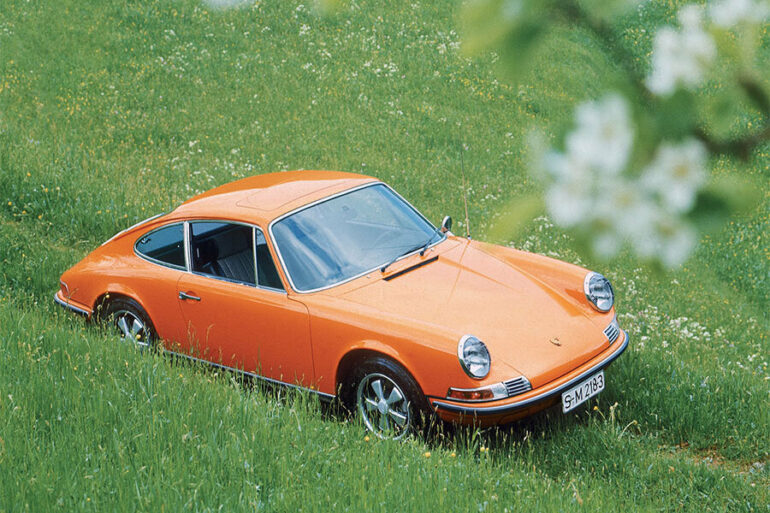
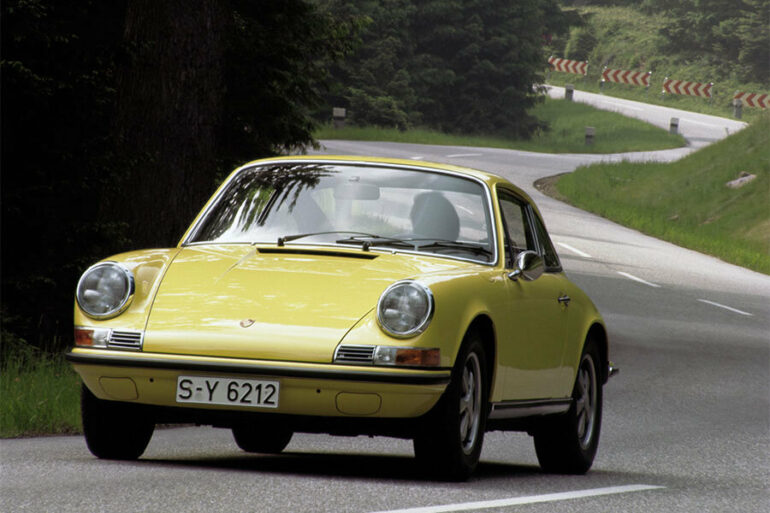
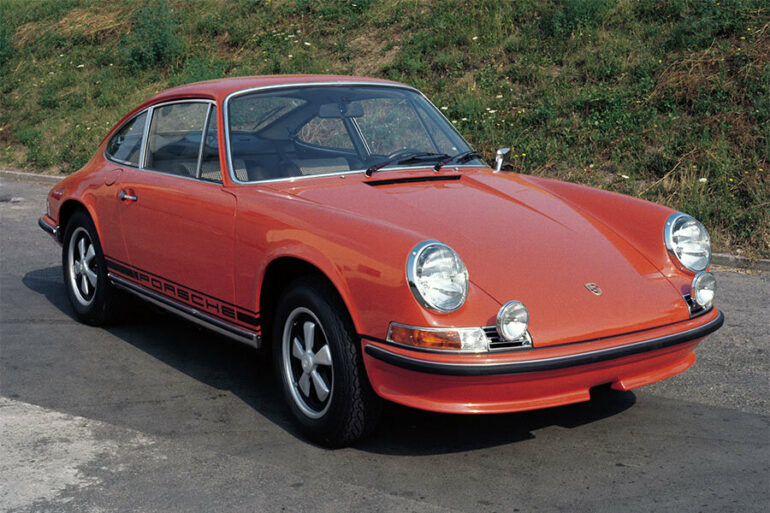

In September 1971, Porsche unveiled the 2.4-litre E-series 911s. These 2.4-litre cars were 1972 and 1973 model year cars. They were offered in three states of tune (911 T, 911 E and 911 S.) and two alternative body styles (Coupe and Targa).
The wheelbase was extended by 3mm thanks to rear suspension mounting points being moved, making the 911 a bit more luxurious to drive and less punishing day to day. The gearbox had a conventional gate pattern.
The engines featured new camshafts, shorter and lighter con rods, reduced height piston crowns cooled by individual oil jet sprays, improved porting, larger big ends, full crankshaft counter-balancing, a crankcase stiffened around the main bearings and a new forged crankshaft.
Production began in August 1971. Porsche’s 1973 model F-series 911s were produced from August 1972 and came with more upgrades.
North American cars got black rubber overrider pads and in January 1973, the fuel-injected US-spec 911 T switched to a Bosch K-Jetronic Injection System and new camshafts were fitted. Production of the F-series 911 continued until July 1973.
We dig into some of the data surrounding the first generation Porsche 911, including production numbers, specifications, chassis numbers, sales brochures, equipment codes, maintenance schedules, common problems, colors and much more.
The initial Porsche 911 — the car that would become the backbone of Porsche’s identity for the next six decades — was primarily designed by Ferdinand Alexander “Butzi” Porsche, the eldest son of Ferry Porsche (and grandson of Ferdinand Porsche, the company’s founder).
1959–1960: Internal discussions begin on a “Type 754 T7” project — an early prototype of the 911, with a longer wheelbase and rear seat concept.
1961–1962: Butzi Porsche finalizes the exterior form; prototypes begin testing.
1963: The Porsche 901 debuts at the Frankfurt Motor Show.
1964: Renamed 911 after Peugeot objected to Porsche using three-digit numbers with a “0” in the middle.
1965: First 911s delivered to customers.
The first generation of the Porsche 911 spans from 1964 to 1973, covering the classic pre-impact-bumper era. Introduced as the Type 901 in 1963 (renamed 911 in 1964), this generation evolved through a series of yearly “body series” — from the A-series (1964) to the J-series (1973) — with key milestones including the transition from short- to long-wheelbase in 1969, the increase in engine size from 2.0 to 2.4 liters, and the introduction of variants like the 911 T, E, and S, culminating in the legendary 1973 Carrera RS 2.7. Characterized by its narrow body, chrome trim, and pure air-cooled mechanical feel, the 1964–1973 911s represent the original and most iconic form of the model — the foundation of everything that followed in Porsche’s lineage.
The F-body (1969) Porsche 911 represents the final iteration of the classic, pre-impact-bumper era, characterized by its slim, chrome-accented design, lightweight body, and high-revving 2.0-liter engine, while the impact-bumper generation (1974–1989) introduced a fundamentally new approach to meet U.S. crash regulations and evolving customer expectations.
The impact-bumper cars featured energy-absorbing bumpers integrated into a stronger, heavier body with revised crash structures, larger engines (2.7 to 3.2 liters), improved drivability, and greater refinement. These safety and engineering changes, along with the shift from a pure sports car to a more usable and durable grand tourer, mark a clear technological and philosophical break between the delicate, minimalist feel of the classic F-body 911s and the more modern, everyday-capable impact-bumper generation that defined the 1970s and 1980s.
Cars prior to the impact-bumper as considered the first generation Porsche 911 and sometimes referred to as the F-Body 911 generation, while impact-bumper cars are considered G-Body cars or second generation Porsche 911s.
The original Porsche 911, introduced in 1964, was a remarkably innovative sports car that redefined what a compact performance machine could be. At a time when most sports cars relied on front engines and heavy steel construction, the 911 featured a rear-mounted, air-cooled flat-six engine, lightweight unibody design, and independent suspension on all four wheels — a combination that delivered exceptional balance, agility, and everyday usability. Its design, led by Ferdinand Alexander “Butzi” Porsche, blended functional engineering with timeless aesthetics: a low-slung silhouette, upright headlights, and flowing fastback shape that became instantly recognizable. The car’s blend of precision engineering and minimalist form made it unlike anything else on the road.
What made the 911 truly special, though, was how it evolved without losing its identity. Its compact footprint and efficient layout allowed Porsche to continually refine performance without compromising the car’s soul. The 911 could serve as a refined touring car one day and a race winner the next — competing successfully in rallies, endurance races, and circuit events worldwide. That versatility, combined with bulletproof engineering and a distinct driving feel — light steering, mechanical precision, and the signature howl of the flat-six — created a legend. The original 911 wasn’t just a new sports car; it was a new concept in performance design, one that balanced usability, innovation, and character in a way no rival had achieved.
The first-generation Porsche 911 was impressively quick for its time, offering genuine high-performance capability while maintaining everyday usability — one of the key reasons it became legendary. The earliest 1964–1965 2.0-liter 911 produced 130 hp and could reach 0–60 mph in around 8.5–9.0 seconds, topping out at about 130 mph (210 km/h) — figures that rivaled or beat most contemporary sports cars like the Jaguar E-Type or Corvette Sting Ray. When the 911 S debuted in 1967 with 160 hp, it sharpened performance further, cutting 0–60 to around 7.0 seconds and achieving 140+ mph (225 km/h) — remarkable for a small, air-cooled six-cylinder car under 2,400 pounds.
By 1969, Porsche had refined the formula with the long-wheelbase 911 E and 911 S featuring mechanical fuel injection (MFI), offering even smoother power delivery and livelier mid-range acceleration. The later 2.2-liter and 2.4-liter models (1970–1973) improved torque and flexibility, making the 911 both faster and easier to drive quickly — especially with the stronger 915 gearbox introduced in 1972. The pinnacle came with the 1973 Carrera RS 2.7, which could sprint to 60 mph in just 5.5 seconds and exceed 150 mph (240 km/h), putting it firmly in supercar territory of the era. Beyond straight-line speed, however, the early 911’s brilliance lay in its nimble handling, lightweight balance, and mechanical purity — qualities that made it devastatingly quick on winding roads and race tracks long before stopwatch numbers told the full story.
Among the first-generation Porsche 911s, many enthusiasts consider the 1973 911 Carrera RS 2.7 to be the ultimate variant — and one of the greatest sports cars ever made. With its 2.7-liter, 210-hp flat-six, lightweight body, and the now-iconic ducktail rear spoiler, it was the first production 911 to truly bridge the gap between road and race car. It offered blistering performance for its day, sublime balance thanks to its long-wheelbase chassis, and mechanical fuel injection that delivered sharp throttle response. Beyond the RS, the 1969–1971 911S models are also highly coveted for their purity and balance — especially the 1969 “F-series” 911S, which combined the first long-wheelbase design with the rev-happy 2.0-liter MFI engine, making it an incredibly precise and rewarding driver’s car.
As for years to avoid, 1966–1968 short-wheelbase cars can be trickier to live with, particularly for less experienced drivers, as their shorter wheelbase made handling twitchier and less predictable at the limit. The 1968 model year also saw some awkward transitions in emissions and safety compliance, especially for U.S. cars, which lost power and certain features due to new regulations. Early 1965–1967 cars, while historically significant, require careful ownership due to their rarity, age, and parts sourcing challenges. In short: if you want the purest driving experience, the 1969–1971 911S or E is a sweet spot; if you want the most collectible and thrilling, nothing surpasses the 1973 Carrera RS 2.7 — but expect to pay accordingly.
If you’re looking at buying a used first-generation Porsche 911, expect a wide range in prices — driven by variant, condition, originality, provenance and how extreme the model is.
According to Hagerty valuation data, a 1969 911 T Targa (entry variant of the long‐wheelbase F-body era) can range from around US $57,000 in “good” condition to about US $120,000 or more in concours “best in world” condition. Some of the earlier short-wheelbase (SWB) cars (1964-68) or rare performance models are already being seen in the high‐hundreds of thousands region. For example, a listing for a 1966 911 was shown at ~$185,000. On the other hand, more ordinary versions, lesser condition, or non-matching numbers cars can still cost significantly less — though “cheap first-generation 911” is relative, because even low-end examples are now fetching tens of thousands of dollars.
Variant matters a lot: A 911 S (higher performance) or the ultra‐desirable 1973 911 Carrera RS 2.7 will command dramatically more than a base 911 T. Originality / matching numbers: Cars that are restored to original specification, with correct engine/transmission, original colour, documented provenance will pull a premium.Condition level: In collector parlance: “#1” (concours) condition often means costs well above the median; “#3” or “#4” (good/fair) condition cost much less. Rarity & desirability: Short‐wheelbase SWB 911s (1964-68) are rarer and becoming more collectible, so they often command stronger value. Long‐wheelbase F-body & early G-body cars are more plentiful (relatively) so price spread is broader. Market trends: The market is rising; what was “entry level” a few years ago is not necessarily so now.
If I were to pick a rough range: for a “good” condition standard first-generation 911 (say an F-body 911 T or 911 E) you might expect US$60,000-120,000 as a ballpark, while rare or high‐performance examples (911 S, RS) are well into six figures — US$200k+ and up depending on spec and provenance. On the flip side, if you find one in poor condition needing full restoration, you may find prices into the lower tens of thousands (especially non‐matching, heavily modified, or badly rusted cars) — though the restoration costs for these cars are significant.
Yes — the first-generation Porsche 911 (1964–1973) underwent several major updates that transformed it from a raw, lightweight sports car into a more refined and powerful performance icon. The biggest early change came in 1969 with the F-series, which introduced the long-wheelbase chassis (extended by 57 mm) to improve stability and reduce the tail-happy handling of the short-wheelbase cars. That same year, Porsche restructured the lineup into 911 T, E, and S models, added Bosch mechanical fuel injection (MFI) on the E and S, and made subtle suspension and braking upgrades that set the template for all future 911s.
Further evolution followed with the 2.2-liter engines in 1970 (G-series), the 2.4-liter engines and stronger 915 gearbox in 1972, and the introduction of the external oil filler flap for improved weight distribution (though it was dropped the next year after confusion at fuel stations). The first generation culminated in the legendary 1973 Carrera RS 2.7, which added a larger engine, lightweight bodywork, and the signature “ducktail” spoiler — a revolutionary step for aerodynamics and performance. Across its nine-year run, the 911 evolved dramatically in engineering sophistication while retaining the timeless design and rear-engine layout that made it an icon from the start.
Join Our Porsche Community
Sign up for our weekly Porsche newsletter. The latest Porsche news, rumors, reviews and more delivered to your inbox. Cool Porsche stuff perfect for the flat-six obsessed.